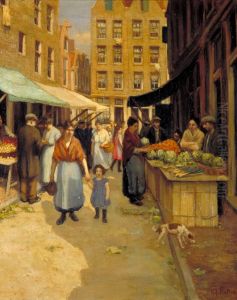Gerard Johan Staller Paintings
Gerard Johan Staller, born on September 5, 1880, in Amsterdam, was a Dutch painter known for his vibrant and dynamic scenes that often depicted city life and leisure activities. He was part of the second generation of Amsterdam Impressionists, a group that continued the legacy of impressionist painting in the Netherlands, following the initial movement that spread across Europe in the late 19th century.
Staller received his formal art education at the Rijksakademie van beeldende kunsten in Amsterdam, where he studied under professors such as August Allebé and Carel Dake. These years were crucial in shaping his artistic vision and proficiency in the techniques of impressionism. His style was characterized by a keen observation of light and color, which he used to capture the bustling atmosphere of urban environments.
Throughout his career, Staller focused on the portrayal of Amsterdam, its people, and the city's surroundings. His works often featured the canals, streets, and parks, populated with figures that reflected the diversity of city life. He was particularly adept at depicting the effects of sunlight on water, a subject that fascinated many impressionists.
Staller's contribution to Dutch art was significant, as he helped to sustain the impressionist tradition in the Netherlands during a period when modernist movements were taking hold. Despite this, he managed to adapt his work to the changing tastes of the time, integrating some elements of modernism without abandoning his impressionist roots.
Gerard Johan Staller's paintings were widely exhibited during his lifetime, and he participated in numerous group and solo exhibitions. His work was appreciated for its liveliness and the joyfulness of the scenes he portrayed. Today, his paintings can be found in various Dutch museums and collections, where they continue to be admired for their historical value and artistic charm.
Staller's life was devoted to art, and he continued painting until his death on November 23, 1956. His legacy lives on through his works, which stand as a testament to the enduring appeal of impressionist painting and its ability to capture the essence of a moment in time.
